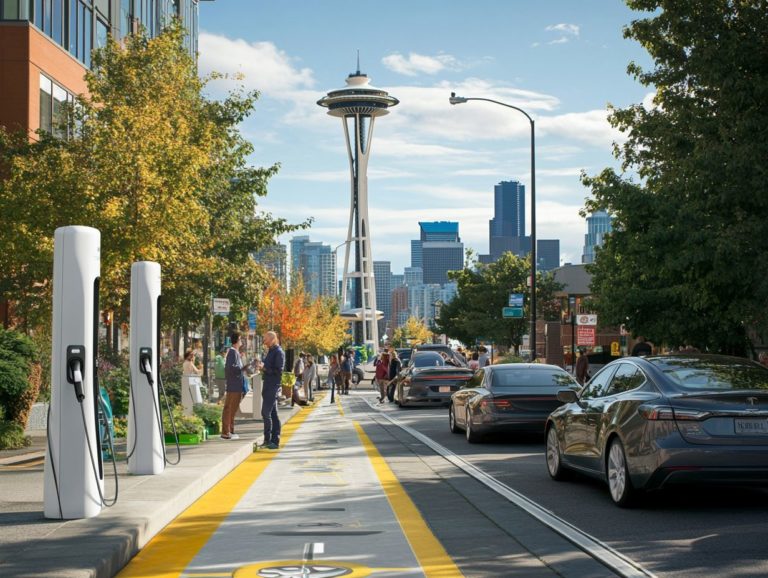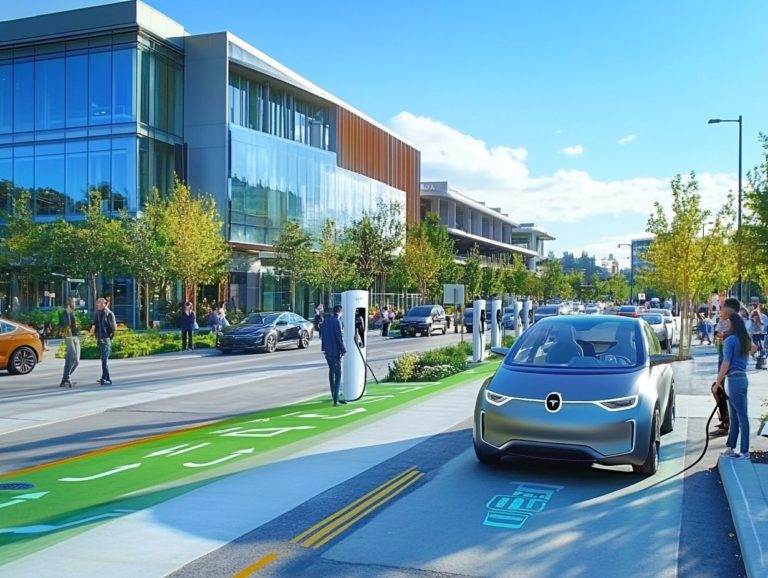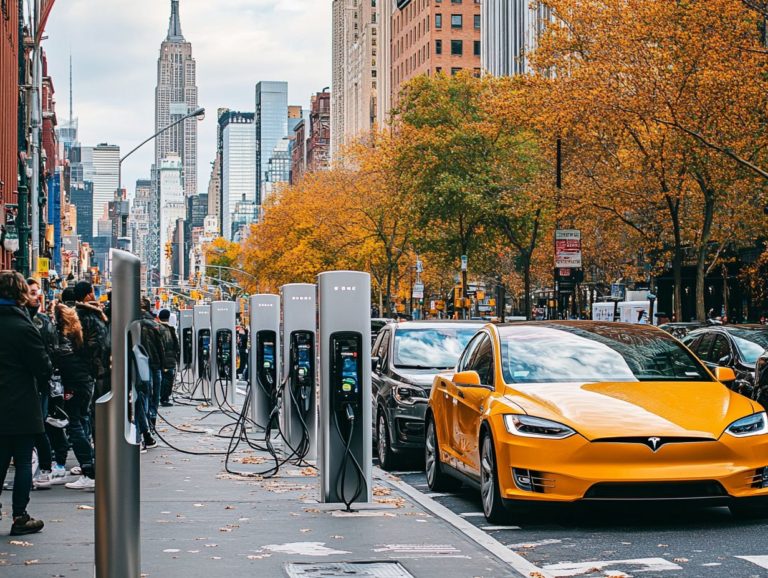exploring the cost of public ev charging
As electric vehicles (EVs) gain traction, the demand for robust public charging infrastructure has become increasingly critical. Don’t miss out on the electric revolution! Public EV charging is vital for a sustainable future.
You may find that the limited availability of charging stations presents genuine challenges, whether you re a seasoned EV owner or contemplating your first purchase. This article delves into the various types of public EV charging stations, along with the associated costs of installation and maintenance, as well as the factors that influence these expenses.
It also sheds light on incentives and partnerships aimed at making public EV charging more accessible and affordable for everyone. Explore the evolving landscape of public EV charging to grasp its implications for the future of electric mobility.
Contents
- Key Takeaways:
- The Need for Public EV Charging
- Types of Public EV Charging Stations
- Costs of Public EV Charging
- Factors Affecting Public EV Charging Costs
- Incentives and Programs for Lowering Costs
- Frequently Asked Questions
- What is the average cost of using public EV charging stations?
- What factors can affect the cost of public EV charging?
- Are there any additional fees associated with public EV charging?
- Can I save money by using public EV charging instead of charging at home?
- Are there any ways to estimate the cost of public EV charging before using a station?
- Is there a difference in cost between charging an EV and fueling a gas-powered car?
Key Takeaways:
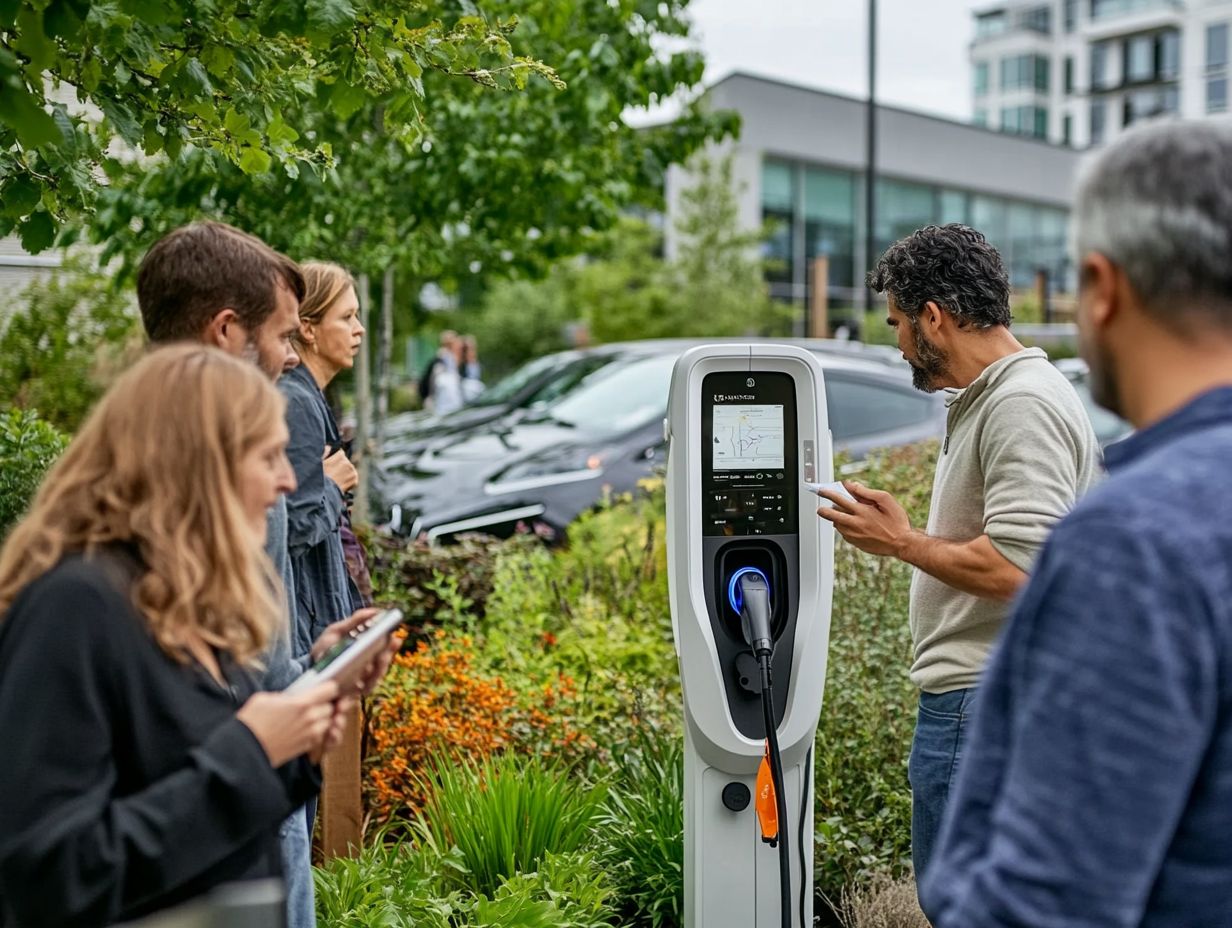
- The need for more public EV charging stations is clear.
- Installation and maintenance costs affect both owners and EV users.
- Incentives like tax credits and rebates can help reduce costs.
The Need for Public EV Charging
As electric vehicles (EVs) become more popular, the necessity for robust public EV charging infrastructure is increasingly evident. With a notable surge in electric vehicle registrations, especially in regions like California, it s crucial to respond to the growing demand for public charging stations.
This shift goes beyond convenience. It aligns with sustainability goals to reduce fossil fuel reliance and promote eco-friendly driving. For EV owners, having accessible charging options is essential to support their electric mobility journeys and enhance the longevity of their battery electric vehicles.
Increasing Demand for Electric Vehicles
Electric vehicle registrations are rising. Factors like high fuel costs and attractive incentives, such as federal tax credits, make electric cars appealing. This shift is fueled by a growing awareness of environmental issues.
You, along with many others, are becoming more conscious of the need to reduce carbon footprints and take action against climate change. Advancements in EV technologies are also important. They enable longer ranges and faster recharge times, making the transition to electric vehicles more practical than ever.
Industry leaders, such as Tesla and the Nissan LEAF, have set impressive benchmarks for innovation, shaping your preferences and sparking an interest in cleaner transportation solutions. Recent statistics reveal that EV sales skyrocketed by 40% just last year, highlighting a significant trend toward sustainability in personal mobility that you may want to embrace.
Challenges of Limited Charging Infrastructure
One of the primary challenges you face when adopting electric vehicles is the limited charging infrastructure, which directly impacts your charging patterns and overall experience as an EV owner. This scarcity of reliable charging stations can lead to what many call “range anxiety,” leaving you concerned about whether you’ll find a charging point in time.
As a result, you might find yourself meticulously planning your routes around available charging locations. This complicates your everyday travel and makes spontaneous trips feel like a distant dream. This inadequacy can also lead to long wait times at overcrowded stations, adding a layer of frustration and inconvenience to your journey.
To alleviate these issues, it s crucial for stakeholders to consider the following steps:
- Expanding network options
- Investing in fast-charging stations
- Employing smart technologies for better real-time data on charger availability
Collaborations between governments, private companies, and community organizations could create a more robust charging ecosystem. This would ultimately make electric vehicle ownership a more viable and attractive option for you.
Types of Public EV Charging Stations
Public EV charging stations are available in various types, each meticulously crafted to meet the diverse needs and circumstances of electric vehicle users. You ll find Level 1 and Level 2 charging options, as well as DC fast charging, ensuring that you have the right solution for your charging requirements.
In conclusion, the importance of public charging infrastructure cannot be overstated. Embracing electric vehicles not only benefits you as an individual but also contributes to a cleaner, more sustainable future. Join the movement for cleaner transportation today by supporting public charging development!
Charging Types for Electric Vehicles
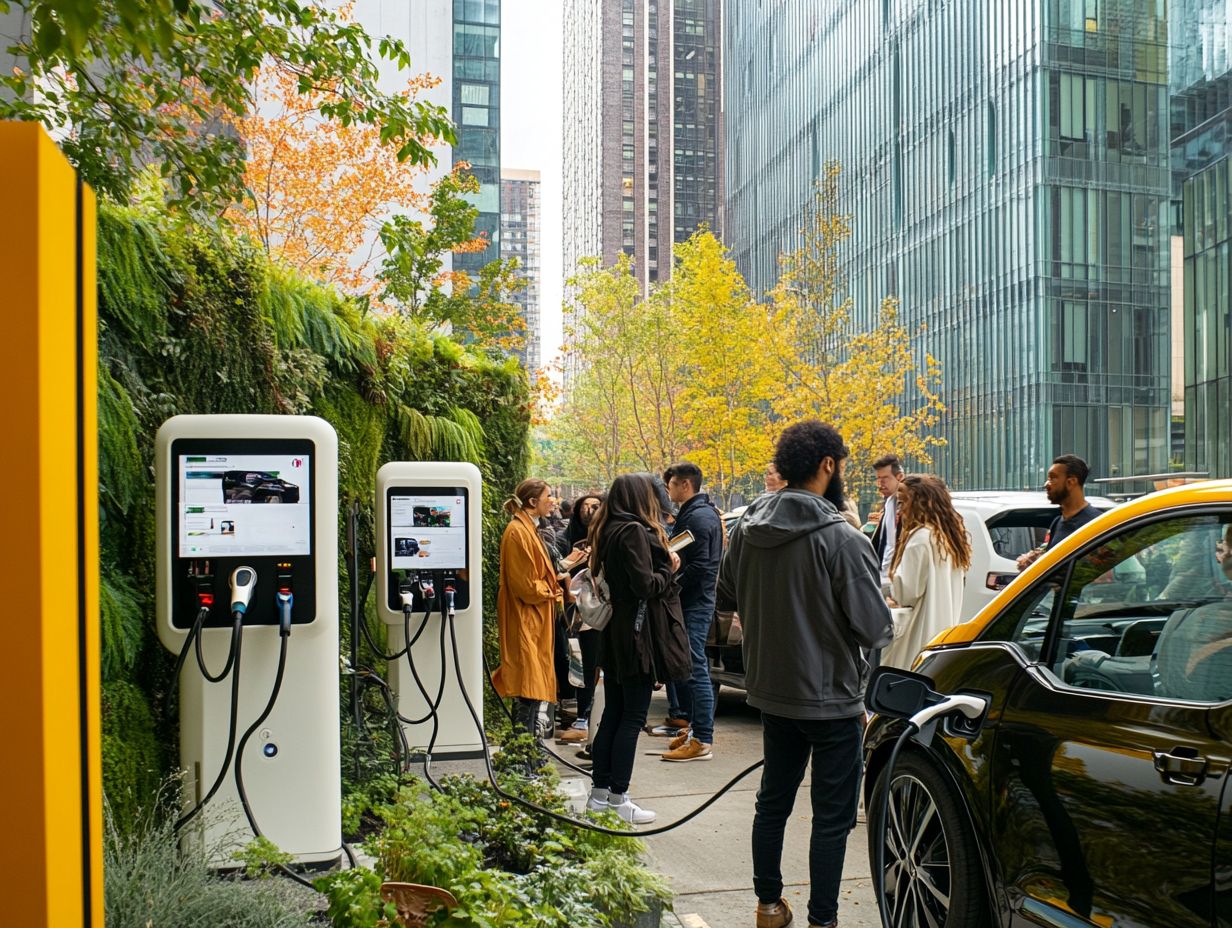
There are three main types of public EV charging stations: Level 1, Level 2, and DC fast charging. Each one is designed to meet different charging needs for electric vehicle owners.
The power levels and charging times for these options vary significantly. It s crucial to select the right station based on your situation.
Level 1 charging uses standard home outlets and typically offers about 2 to 5 miles of range per hour. This option is perfect for overnight charging at home or for short daily commutes.
Level 2 charging stations provide a faster alternative, delivering 10 to 60 miles of range per hour. You ll often find these in public parking lots, workplaces, and shopping centers, making them a convenient choice for your daily needs.
In a hurry? DC fast charging stations are your best choice! These powerhouses can deliver up to 350 kilowatts, allowing you to charge up to 80% of your battery capacity in about 30 minutes.
This variety of charging options influences your charging strategy. It s essential to consider the location and availability of these stations for seamless travel and effective battery management.
Costs of Public EV Charging
Understanding the costs linked to public EV charging is essential for both electric vehicle owners and businesses investing in charging infrastructure.
These expenses cover many factors, from installation to ongoing maintenance and usage fees. All play a vital role in the overall financial landscape.
Installation and Maintenance Expenses
Installation and maintenance costs for public charging stations can vary significantly. Factors like location, charging equipment quality, and local regulations all influence these expenses.
Initial investment can range from several thousand dollars for basic setups to much higher for advanced solutions. Ongoing maintenance costs, covering service contracts, equipment upgrades, and utility fees, can accumulate over time and impact overall profitability.
For businesses eyeing the EV charging market, understanding these financial implications is vital. A well-crafted financial plan will help you manage expenses effectively and illuminate potential revenue streams in the growing electric vehicle infrastructure landscape.
Costs for Electric Vehicle Owners
As an EV owner, understanding the costs tied to public charging such as fees and electricity consumption is crucial for managing your overall expenses.
Charging fees can vary considerably among different locations and service providers. Some may offer flat rates, while others charge by the kilowatt-hour, leading to varying costs for you.
Fortunately, these expenses are often lower than traditional gasoline prices, making electric vehicles a more economical choice over time. By adopting strategic charging practices, like recharging during off-peak hours, you can maximize your savings.
This approach allows you to benefit from available incentives and energy rate fluctuations while keeping your overall expenses in check.
Factors Affecting Public EV Charging Costs
Several factors influence the cost of public EV charging, including location, local electricity rates, and any usage or demand fees imposed by charging stations. For a deeper insight, consider understanding the cost of home EV charging.
Understanding these elements can help you navigate the overall expenses associated with charging your electric vehicle.
Location and Electricity Rates
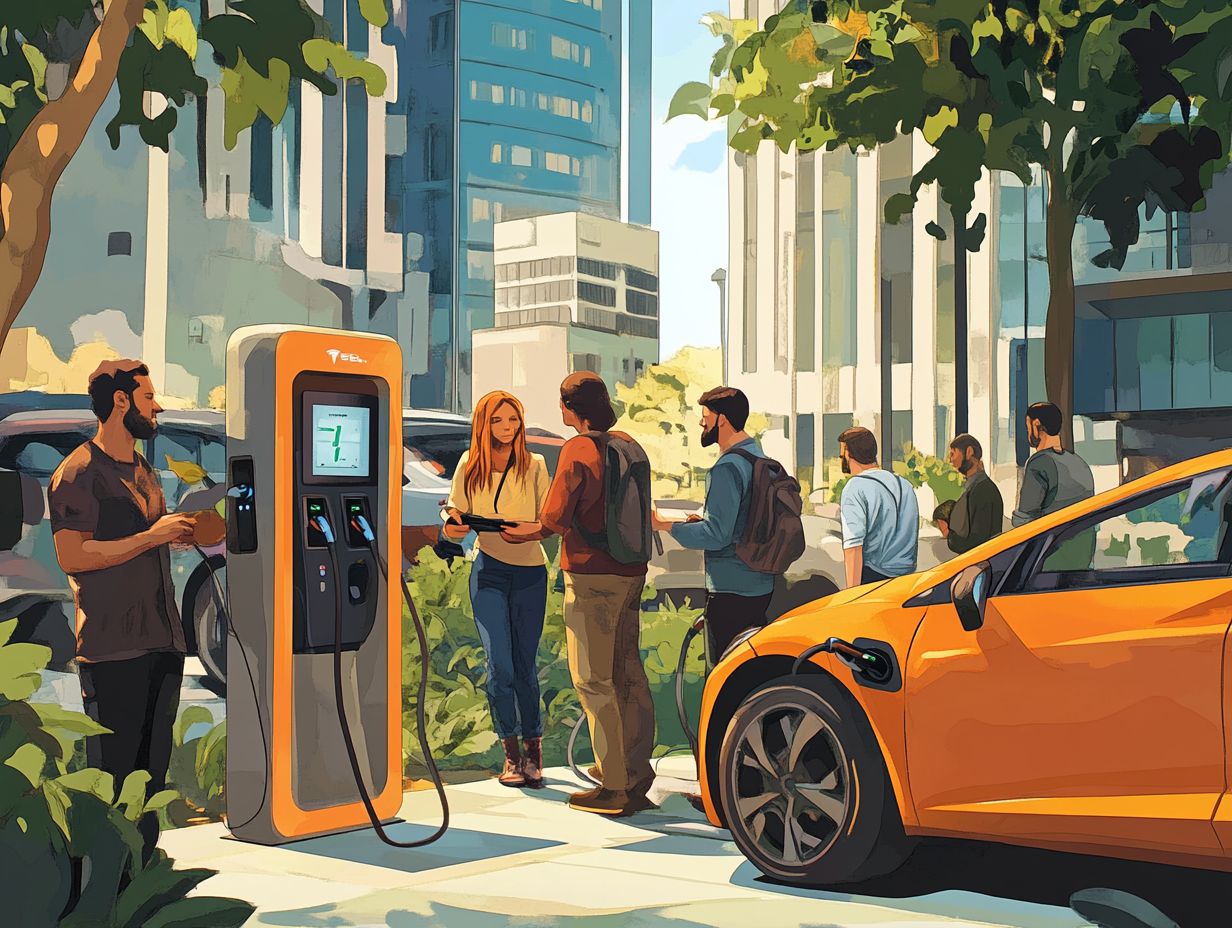
The location of public charging stations plays a pivotal role in determining electricity rates and the cost of charging in public. Access and convenience are paramount for EV owners.
This variation in rates can be influenced by regional energy sources, local policies, and fluctuating demand. Each factor carries significant weight.
For example, areas that prioritize renewable energy often provide lower rates, resulting in a more economical charging experience. Regions that rely on fossil fuels may impose steeper fees.
The geographic distribution of the charging network also affects overall accessibility. If public charging stations are predominantly concentrated in urban areas, EV owners in rural locations may encounter higher costs and face challenges in locating charging points.
Therefore, ensuring a more equitable distribution of these stations can greatly enhance convenience for all users and encourage broader adoption of electric vehicles.
Usage and Demand Fees
Usage and demand fees can be additional costs that significantly impact your charging expenses as an EV owner, especially during peak usage times.
These fees are charges that vary based on how much electricity people use at a certain time, which can surge during busy periods. Charging during high-demand hours can lead to unexpectedly hefty bills.
Understanding how these fees work is essential for making informed decisions about when and where to charge your vehicle. By exploring strategies like:
- Utilizing off-peak charging,
- Participating in loyalty programs offered by charging networks,
- Opting for home charging solutions,
you can effectively lower your overall expenses. Staying informed about local incentives and time-of-use rates can further enhance the affordability and accessibility of charging your electric vehicle.
Incentives and Programs for Lowering Costs
Incentives and programs designed to reduce the costs of charging electric vehicles are rapidly gaining popularity, offering you financial relief through avenues like tax credits, rebates, and innovative partnerships between the public and private sectors.
Tax Credits and Rebates
Tax credits and rebates are essential in making electric vehicles more affordable for you. They help alleviate some of the financial pressure and encourage a shift in your purchasing decisions within the electric vehicle market.
For example, programs like the federal EV tax credit can grant you up to $7,500 off the price of a qualifying electric car. Many states also offer additional rebates that can range from a few hundred to several thousand dollars, significantly enhancing the appeal of going electric.
Exciting local initiatives, like reduced vehicle registration fees or access to carpool lanes, make going electric even more appealing. Together, these measures not only stimulate demand but also promote a transition towards sustainable energy practices for individual buyers and businesses eager to upgrade their fleets.
Public-Private Partnerships
Public-private partnerships hold remarkable potential for enhancing charging infrastructure. They create a robust collaborative framework between government bodies and electric utilities to bolster electric vehicle adoption.
By pooling resources, expertise, and funding, these alliances can effectively tackle the rising demand for charging stations while promoting innovation within the sector.
Take cities like Los Angeles and Amsterdam; their successful initiatives showcase how strategic collaboration can significantly increase the availability of fast chargers in urban areas, facilitating a smoother transition to electric mobility.
Companies engaged in these partnerships are championing sustainable transportation and seizing business opportunities emerging from a rapidly growing market hungry for reliable charging solutions. With the right strategies in place, they can forge a path toward advancements that benefit both consumers and businesses alike.
Frequently Asked Questions
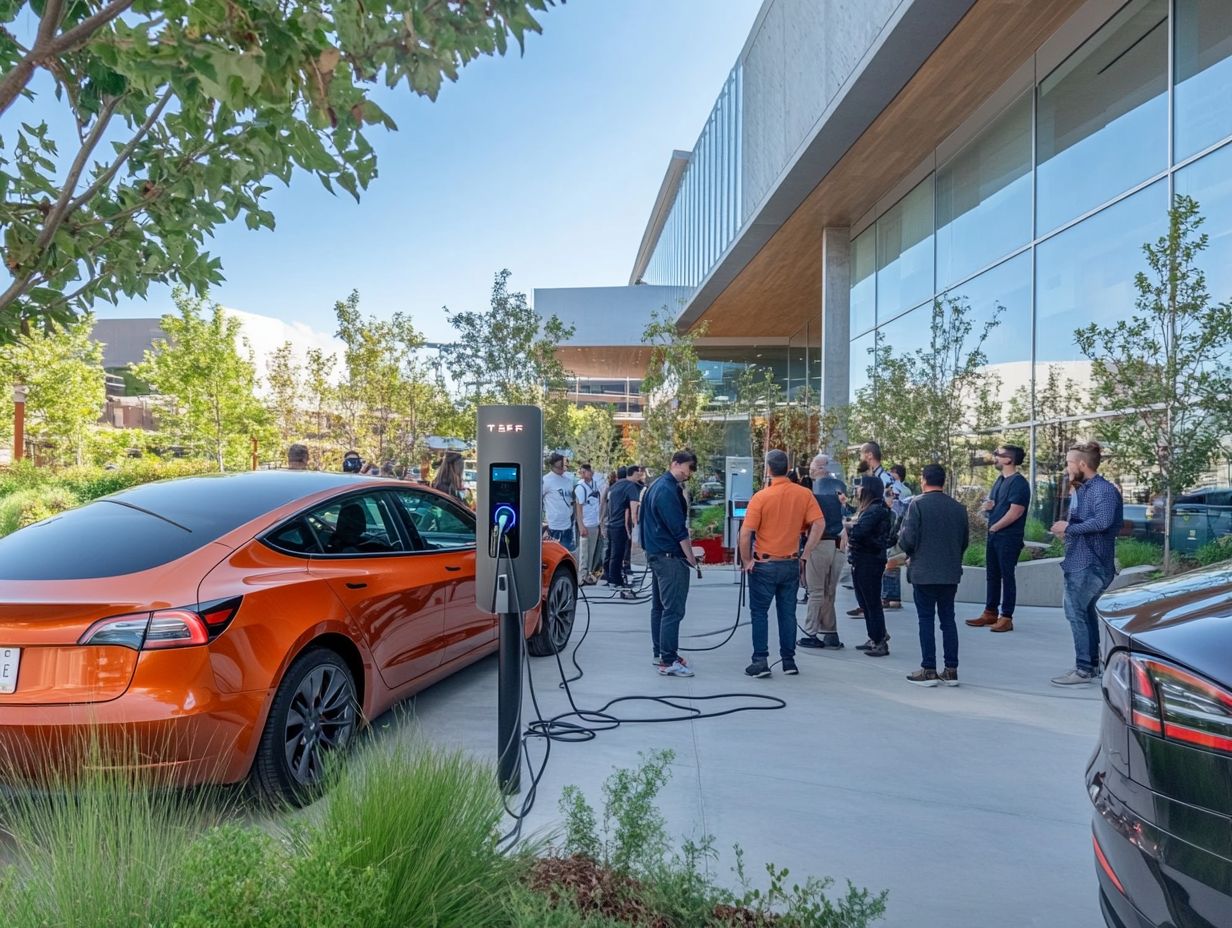
What is the average cost of using public EV charging stations?
Public EV charging costs vary by location and station type. It typically ranges from $0.10 to $0.30 per unit of electricity. Some stations even offer free charging or charge a flat rate.
What factors can affect the cost of public EV charging?
Several factors can affect public EV charging costs, including location, station type, time of day, and state electricity rates. Urban areas usually have higher rates than rural areas. Fast-charging stations typically cost more than level 2 stations, highlighting the benefits of public EV charging stations.
Are there any additional fees associated with public EV charging?
Some public EV charging stations may charge extra fees, such as network access or connection fees. These fees vary by station and network provider. Always check for any additional fees before using a public charging station.
Can I save money by using public EV charging instead of charging at home?
Your savings depend on your electricity rates! In some cases, charging at home is cheaper, especially with a time-of-use plan. However, public charging can save you money by reducing wear and tear on your home charger and qualifying for utility rebates or incentives for EV owners.
Are there any ways to estimate the cost of public EV charging before using a station?
Don t head to a charging station without checking costs! Several mobile apps and websites can help you estimate the cost of public EV charging. These tools consider your location, vehicle type, and charging station rates to provide an estimated price for your charging session.
Is there a difference in cost between charging an EV and fueling a gas-powered car?
Yes, there is a cost difference between charging an EV and fueling a gas-powered car. On average, charging an EV is cheaper than filling up a gas-powered car. The cost per mile for an EV is typically less than half the cost of a gas-powered car, making EVs a more cost-effective transportation option.


